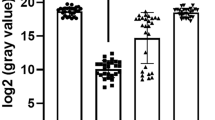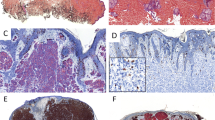Abstract
The effect of melanin bleaching on the immunoreactivity of the MIB1-Ki67 antigen in pigmented melanocytic lesions was investigated. Eight paired non-pigmented and heavily pigmented malignant melanomas (6 primary melanomas and 2 secondary melanomas) were selected. Avidin–biotin immunoperoxidase complex (ABC) and microwave antigen retrieval were used in immunostaining. Sections were incubated with 10% H2O2 for 24 h before immunostaining with primary antibody MIB1, or after the completion of immunostaining. Non-bleached controls were obtained by conducting the identical staining but omitting the bleaching procedure. In all heavily pigmented lesions bleached by 10% H2O2 before or after immunostaining, the melanin was bleached effectively and MIB1-positively stained cells were clearly seen. Cell counting in the non-pigmented group found that there were no significant differences in the percentage of MIB1-positive melanoma cells (%MIB1) between non-bleached controls and those sections which had been bleached by 10% H2O2 either before or after the immunostaining. The results suggest that hydrogen peroxide can effectively bleach melanin in pigmented melanocytic lesions without significantly affecting MIB1-Ki67 immunolabelling.
Similar content being viewed by others
References cited
Albrecht S, Jambrosic JA, Kahn HJ (1989) Nucleolar organizer regions in superficial spreading melanoma with nodule. Mod Pathol 2: 666-670.
Alexander RA, Hiscott PS, Hart RL, Grierson I (1986) Effect of melanin bleaching on immunoperoxidase, with reference to ocular tissues and lesions. Med Lab Sci 43: 121-127.
Cattoretti G, Becker MHG, Key G, Duchrow M, Schlüter C, Galle J, Gerdes J (1992) Monoclonal antibodies against recombinant parts of the Ki-67 antigen (MIB1 and MIB3) detect proliferating cells in microwave-processed formalin-fixed paraffin sections. J Pathol 168: 357-363.
Gerdes J, Becker MHC, Key G, Cattoretti G (1992) Immunohistological detection of tumour growth fraction (Ki-67 antigen) in formalin-fixed and routinely processed tissues. J Pathol 168: 85-87.
Gerdes J, Lemke H, Baisch H, Wacker H, Schwab U, Stein H (1984) Cell cycle analysis of a cell proliferation-associated human nuclear antigen defined by the monoclonal antibody Ki-67. J Immunol 133: 1710-1715.
Gerdes J, Schwab U, Lemke H, Stein H (1983) Production of a mouse monoclonal antibody reactive with a human nuclear antigen associated with cell proliferation. Int J Cancer 31: 13-20.
Graham RC, Karnovsky MJ (1966) The early stages of absorption of injected horseradish peroxidase in the proximal tubules of mouse kidney: ultrastructural cytochemistry by a new technique. J Histochem Cytochem 14: 291-302.
Hsu S-M, Raine L, Fanger H (1981) Use of avidin-biotin-peroxidase complex (ABC) in immunoperoxidase technique: a comparison between ABC and unlabeled antibody (PAP) procedure. J Histochem Cytochem 29: 577-580.
Key G, Becker MHG, Baron B, Duchrow M, Schlüter C, Flad H-D, Gerdes J (1993) New Ki-67-equivalent murine monoclonal antibodies (MIB1-3) generated against bacterially expressed parts of the Ki-67 cDNA containing three base pair repetitive elements encoding for the Ki-67 epitope. Lab Invest 68: 629-636.
Mackie RM White SI, Seywright MM, Young H (1989) An assessment of the value of AgNOR staining in the identification of dysplastic and other borderline melanocytic naevi. Br J Dermatol 120: 511-516.
McCormick D, Chong H, Hobbs C, Datta C, Hall PA (1993) Detection of the Ki-67 antigen in fixed and wax-embedded sections with the monoclonal antibody MIB1. Histopathology 22: 355-360.
Sawhney N, Hall PA(1992) Ki67-structure, function, and new antibodies. J Pathol 168: 161-162.
Talve LAI, Collan YUI, Alanen KA (1995) Bleaching of melanin before image cytometry of the DNA Content of pigmented skin tumours. Anal Quant Cytol Histol 17: 344-350.
Yu CC-W, Woods AL, Levison DA (1992) The assessment of cellular proliferation by immunohistochemistry: a view of currently available methods and their applications. Histochem J 24: 121-131.
Author information
Authors and Affiliations
Rights and permissions
About this article
Cite this article
Lawrence Li, LX., Crotty, K.A., Kril, J.J. et al. Method of Melanin Bleaching in MIB1-Ki67 Immunostaining of Pigmented Lesions: A Quantitative Evaluation in Malignant Melanomas. Histochem J 31, 237–240 (1999). https://doi.org/10.1023/A:1003528507828
Issue Date:
DOI: https://doi.org/10.1023/A:1003528507828




